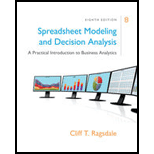
Spreadsheet Modeling & Decision Analysis: A Practical Introduction To Business Analytics, Loose-leaf Version
8th Edition
ISBN: 9781337274852
Author: Ragsdale, Cliff
Publisher: South-Western College Pub
expand_more
expand_more
format_list_bulleted
Concept explainers
Question
Chapter 3, Problem 9QP
Summary Introduction
To develop: A spreadsheet model for the problem and solve it using solver.
Expert Solution & Answer
Want to see the full answer?
Check out a sample textbook solution
Students have asked these similar questions
Defining the scope of an information technology project is a challenging task due to the uncertainties in time, cost, technologies, quality, human resources, and so on. Address the following questions.
How would techniques of project scope management ensure the project objectives can be achieved in an information technology project?
Can any of the agile approaches be engaged in the project scope management for a better efficiency?
Directions: In Chapter 1 we introduce Project Management.
Why is there a new or renewed interest in project management?
2. What is a project? What are its main attributes? What are some examples of different size projects?
3. What are project constraints? How do they affect the project management process?
4. What is the relationship between Projects, and operations?
5. What are some skills recommended for project managers? Why would these skills be important in the management of projects?
6. What is the PMI Talent Triangle and what role do they play in the project management field?
Do you think businesses ever mistakenly cling to outdated ideas of "acceptable" profit, even as their industry conditions shift?
Chapter 3 Solutions
Spreadsheet Modeling & Decision Analysis: A Practical Introduction To Business Analytics, Loose-leaf Version
Ch. 3 - Prob. 1QPCh. 3 - Prob. 2QPCh. 3 - Prob. 3QPCh. 3 - Prob. 4QPCh. 3 - Prob. 5QPCh. 3 - Prob. 6QPCh. 3 - Refer to question 19 at the end of Chapter 2....Ch. 3 - Prob. 8QPCh. 3 - Prob. 9QPCh. 3 - Prob. 10QP
Ch. 3 - Prob. 11QPCh. 3 - Prob. 12QPCh. 3 - Prob. 13QPCh. 3 - Prob. 14QPCh. 3 - Prob. 15QPCh. 3 - Prob. 16QPCh. 3 - Prob. 17QPCh. 3 - Tuckered Outfitters plans to market a custom brand...Ch. 3 - Prob. 19QPCh. 3 - Prob. 20QPCh. 3 - Prob. 21QPCh. 3 - Prob. 22QPCh. 3 - Prob. 23QPCh. 3 - Prob. 24QPCh. 3 - Prob. 25QPCh. 3 - Prob. 26QPCh. 3 - A manufacturer of prefabricated homes has decided...Ch. 3 - Prob. 28QPCh. 3 - Prob. 29QPCh. 3 - Prob. 30QPCh. 3 - Prob. 31QPCh. 3 - Prob. 32QPCh. 3 - Prob. 33QPCh. 3 - Prob. 34QPCh. 3 - Prob. 35QPCh. 3 - Prob. 36QPCh. 3 - Prob. 37QPCh. 3 - Prob. 38QPCh. 3 - Prob. 39QPCh. 3 - Prob. 40QPCh. 3 - Prob. 41QPCh. 3 - Prob. 42QPCh. 3 - Prob. 43QPCh. 3 - Prob. 44QPCh. 3 - A natural gas trading company wants to develop an...Ch. 3 - Prob. 46QPCh. 3 - The CFO for Eagle Beach Wear and Gift Shop is in...Ch. 3 - Prob. 48QPCh. 3 - Prob. 1.1CCh. 3 - Prob. 1.2CCh. 3 - Prob. 1.3CCh. 3 - Prob. 1.4CCh. 3 - Prob. 2.1CCh. 3 - Prob. 2.2CCh. 3 - Prob. 2.3CCh. 3 - Prob. 2.4CCh. 3 - Prob. 2.5CCh. 3 - Kelly Jones is a financial analyst for Wolverine...
Knowledge Booster
Learn more about
Need a deep-dive on the concept behind this application? Look no further. Learn more about this topic, management and related others by exploring similar questions and additional content below.Similar questions
- Question 2/60 Correction is always better than: Maintenance Containment Root cause identification Preventionarrow_forwardQuestion 47 / 60 Root cause is related to: The "x" on y=f(x) The "y" on y=f(x) The "=" on y=f(x) The "f" on y=f(x)arrow_forwardQuestion 58/60 Ishikawa is more applicable to projects related to lead time. This statement is: True Falsearrow_forward
- Question 49 / 60 Lean Six Sigma is focused on solving highly complex problems. This statement is: False Truearrow_forwardQuestion 60 / 60 Lean Six Sigma guarantees that all problems can be solved. This statement is: False Truearrow_forwardQuestion 23/60 Sigma Level is is used to evaluate how stable my process is. This statement is: True Falsearrow_forward
- Question 24/60 Lean Six Sigma is focused on problems that present low complexity. This statement is: False Truearrow_forwardQuestion 19/60 Control Charts are used to evaluate process stability. This statement is: False Truearrow_forwardQuestion 18/60 We must find the root cause in a Lean Six Sigma project. This statement is: False Truearrow_forward
- Question 17/60 Without data you cannot validate root causes. This True False statement is:arrow_forwardQuestion 16/60 Two of the Measurement System Analysis dimensions discussed in this training are Repeatability and Reproducibility. This statement is: True Falsearrow_forwardAverage is important and always sufficient in a baseline analysis of the process. This statement is: False Truearrow_forward
arrow_back_ios
SEE MORE QUESTIONS
arrow_forward_ios
Recommended textbooks for you
 Practical Management ScienceOperations ManagementISBN:9781337406659Author:WINSTON, Wayne L.Publisher:Cengage,
Practical Management ScienceOperations ManagementISBN:9781337406659Author:WINSTON, Wayne L.Publisher:Cengage,

Practical Management Science
Operations Management
ISBN:9781337406659
Author:WINSTON, Wayne L.
Publisher:Cengage,
